
27/9/2021
Introduction
Our spending habits have changed drastically over the last 18 months as the world of retail has been forced online as a result of the global pandemic. Alongside the ever-growing takeover of the digital world, the retail sector has transformed significantly to appeal to a new kind of consumer, with high-street shops and the way we purchase goods set to never be the same.
But what is the current state of retail across the UK, Europe and the rest of the world? We’ve conducted a survey to consumers to find out the current state of retail, consumer attitudes towards shopping and what we can expect as a result of these attitudes in the coming years.
The current state of the high street
The high street is no longer just a shopping haven, nowadays, the high street is made up of different sections. From retail to leisure, the high street is divided up into many sectors, and no two high streets are ever the same.
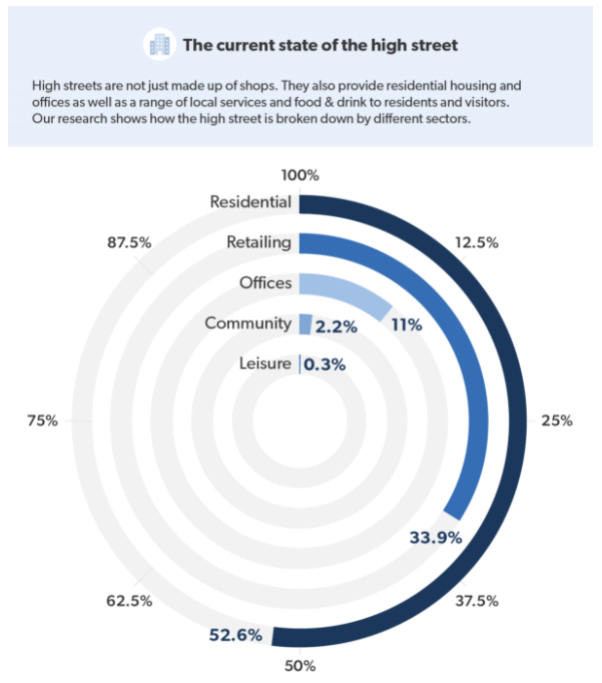
Our finding shows that on average, the residential area makes up the largest part of the high street (53%) with retailing following behind, occupying 34% of the UK high street.
Taking a look at different UK areas, we can see that at 75%, Greenwich has the largest residential space on the high street whereas Selby has the biggest retailing space (63%).
At the other end of the scale, Redditch has the smallest residential space on the high street and Islington has the smallest retailing space (11% and 11% respectively).

The high street is ever-changing, with high street retailers either closing down or shutting dozens of stores. One area that was heavily affected by retail closure is East Northamptonshire - over a 3-year period the region experienced a 35% loss of retail stores on the high street.
Joe, Founder and CEO at Veo talks about the effect lockdown has had on consumer behaviour: “With regard to the effect the pandemic has had on online shopping a number of business leaders (including Jon Roberts of AO.com and Dragon Theo Paphitis) declared as early as May last year that COVID-19 had accelerated 5 years of online shopping behaviour changes "into just five weeks".
Crowdfunding platforms like Seedrs are calling online retail "the fifth emergency service" which is needed for business resilience so organisations can survive.
Even with the rise of online shopping, according to Ethical Consumer, people spent around £3.4bn in local shops during 2019, and as people continue to stay close to home, this figure is set to increase significantly in the future. Research has indicated that 60% of consumers have said that post-pandemic they expect to buy from local shops (compared to 40% shopping locally pre-Covid), giving a promising indication to independent retailers outside of major towns and cities for 2021 and beyond."
The pandemic has changed the way UK consumers shop in-store
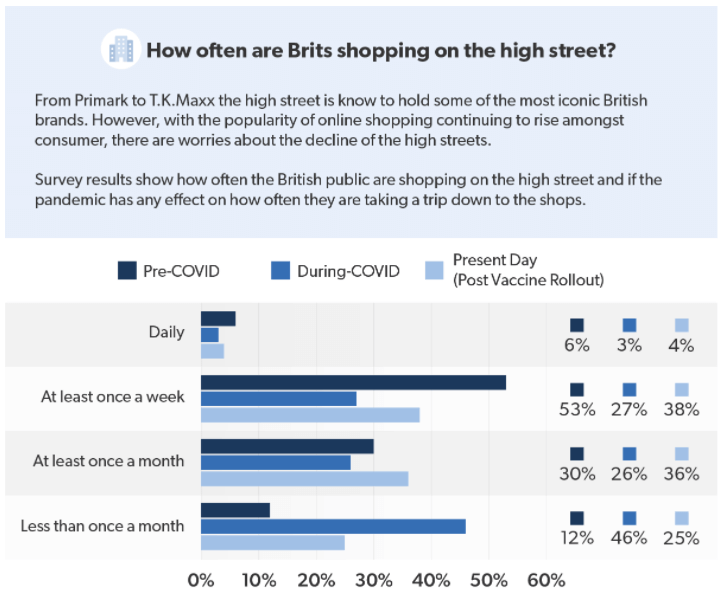
Prior to Covid-19, 59% of Brits were shopping in real life at least once a week, with more than a quarter (27%) of people buying items on the high street at least 2-3 times a week.
In the present day, there has been a 16% drop in the number of people shopping on the high street at least once a week, as only 42% of consumers have returned to buying from there weekly. In fact, a quarter of consumers (25%) are spending on the high street less than once a month.
Daily high street shopping has dropped by 3% during COVID-19 from its original 6% prior lockdown - and has only recovered by a little over 1% currently.
Surprisingly, the majority of Brits have not shifted from offline shopping
With the world opening back, shoppers are finding their way back to the high street. Much to the surprise of experts, who predicted online shopping would take over, in-person shopping still has a hold, as many consumers prefer to buy items in-store, although there has been a shift to online purchasing because of the pandemic.
Savoo has analysed the data to find the products and services customers would deliberately purchase online instead of buying in person, as well as the global changes in the e-commerce market in the upcoming years.
For both Brits and Germans, purchasing in-store is still their preferred option of shopping, as the majority of respondents claim that they have not fully shifted from offline to online purchases for any products or services (35% and 47% respectively).
Almost three in five Brits believe that the high street is still important

As the push for online shopping continues, many UK residents are not ready to let go of high street shopping yet. 59% of UK shoppers say that the high street is still their main way of shopping, compared with only 21% who say the internet is their main way and just a small 4% that admit that all of their shopping is done online.
Having said this, interestingly 62% of consumers say they find better deals online. Despite this, 42% also claim that they spend more money when shopping on the internet, which may be as a result of the extensive time we can spend on sites and the need to buy more options as we cannot experiencing trying anything on in real life.
James Khoury, CEO of Zendbox agreed that the high street still plays an important role in consumer shopping commenting “Whilst it's no secret that the high street has suffered over the course of the pandemic, it's certainly not time to abandon all hope on physical retail outlets. The level of personalisation and convenience that consumers are continually opting for via online channels is overtaking the same approach that is provided in face-to-face retail experiences.
We're already seeing a rise in physical stores adopting experiential retail methods to provide an immersive (and hygienic) in-store experience that rivals that of an online purchase.
Ultimately, this approach to providing an experience is what high street stores will need to offer to stand out and provide that added 'edge' over the convenience of online shopping."
Finding a great deal is what consumers value the most
Shopping is a complete experience for customers and is the reason why many of us continue to visit the high street even though there are alternative methods that can be argued to be more convenient.
From the discovery of the product to interactions with staff members, consumers are on a journey while they look to buy items. However, there is something that they value more than others when it comes to their shopping experience.
When buying something, the top factor for UK shoppers is finding a great deal, according to 49% of respondents.
Other top factors include being able to see and test the item in person (36%), and the speed and convenience of the purchase (33%).
The table below shows the most important things consumers want from their shopping experience:
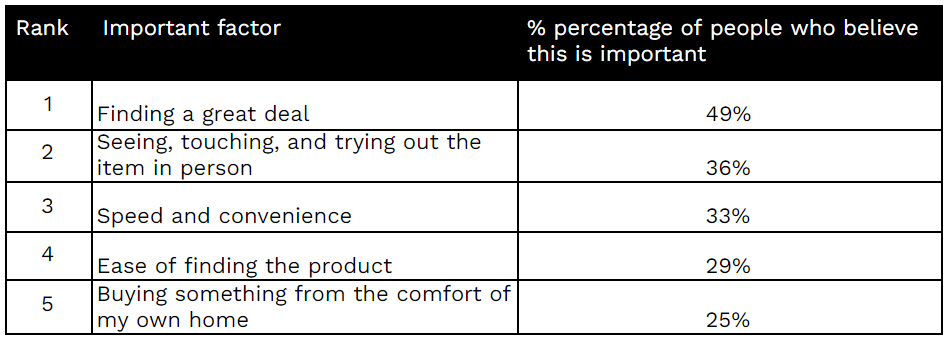
The least important factor listed is financing options available, such as in-store credit card or buy now pay later, only considered by 8%. However as the likes of Klarna continue to become more popular, this may change in the coming years.
Cameron Worth, founder at Sharp End expressed to Savoo how to get people back on the high street “What we are already seeing is that retail is becoming more of a showroom for experience rather than transaction. What we are trying to do now is draw people back into the high street with a heightened and optimised retail experience, which isn’t just around buying stuff but brand experience.
In terms of technology being used, we are starting to see concept stores being opened up all over the place – total reversals of focus rather than flagships stores focusing on transactions they are looking at virtual try-ons, in-store augmented reality that can bring products and assets in-store to life".
Primark is the nation's favourite high street shopping destination
The high street is home to some of the most quintessential British clothing stores. Giving shoppers not only affordability but also accessibility, shopping on the high street sometimes is really the best choice.
With many stores closing down, there are some that we hold closer to our heart than others and would be heartbroken to see go.
Here are Brits top five favourite stores on the High Street that we’d hate to see closed down:
- Primark
- Marks and Spencer
- Tesco
- John Lewis
- T.K.Maxx
It may come as no surprise that Primark is the nation's favourite high street shop. Founded 52 years ago in 1969, the store has built its way into the public heart thanks to inexpensive, fashionable items.
Now worth £1.1 B, over 20 million customers were purchasing men and women’s clothes from the shop in 2020 alone.
Marks and Spencer comes in second as the favourite store, and Tesco rounds off the top three.
As well as our high street favourites, we also have online-only sites that we visit on a regular basis, with many of us having dreamed about visiting the shop in person to partake in its true shopping experience.
We asked the public if you could visit an online store in person, which it would be with the majority answering Amazon (47%). With over 200 million Prime users, the online giant is one of the most popular websites worldwide - so it’s no wonder that many would like to visit a real Amazon store.
The table below shows the top 5 online stores we would like to see in person.
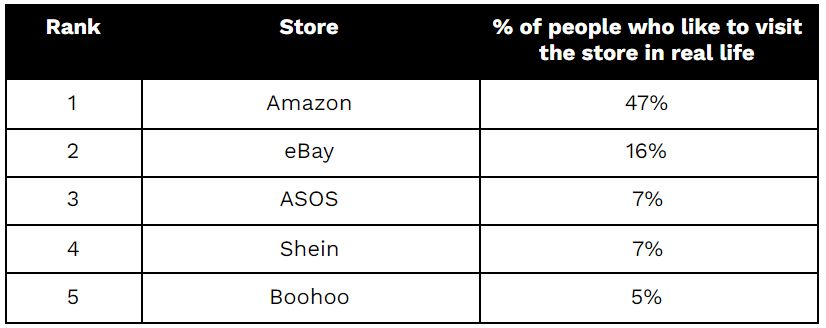
Operating in over 30 countries, eBay comes in second place. Known for people selling their goods, 16% of Brits have their hearts set on visiting the real-life auction marketplace.
Despite its increasing popularity amongst Gen-Z due to the social media platform TikTok, Shein, one of the world’s largest online-only fashion companies, has only placed in 4th. The public is not overly interested in visiting a store of this fast-fashion company.
Boux Avenue and I saw it first saw are the stores Brits care the least about visiting in person- receiving less than 1% votes each (0.64% and 0.88% respectively).
The rise of online spending
The COVID-19 pandemic has changed the way the UK visits and shops on the high street. With lockdown in full effect, retail spaces up and down the country were closed, leaving many Brits turning to alternative ways of shopping in order to get some retail therapy. As a result, many people may never shop in the same way again.
Whilst online shopping isn’t new, the pandemic has accelerated the rate at which consumers are interacting and using it significantly.
The pandemic has changed the way UK consumers shop online

45% of British shoppers were purchasing non-essential items online at least once a week before the national lockdown. At the peak of the pandemic, over half of shoppers (54%) were buying goods online at least once a week.
Many consumers were internet shopping on a more frequent basis, as the percentage of people that online shopped 2-3 times a week increased from 19% to 26% during the lockdown period.
8% of Brits were shopping online daily during the pandemic - which is double the amount before the pandemic.
Online shopping continues to be a popular purchasing method for customers post the high street reopening and the roll-out of the vaccine, with half of Brits (50%) buying non-essential products online at least once a week.
Online shopping spiked during the pandemic, with 4% more people shopping on the internet on a daily basis than before. At this current time, it has decreased by 3% from its peak, leaving it roughly 1% higher than before COVID-19. These figures highlight that the high street still holds a place in the British public heart - with some shoppers preferring to shop in-person rather than over the web.
Savoo spoke to Bernard Meyer an eCommerce marketing specialist at Omnisend about the push the pandemic has had to online shopping. He commented that “The pandemic has shifted nearly everything online, and those brands that were able to make that digital shift flourished. This applies to all types of stores, although high street, being generally larger businesses, were also slower to make that change.
Because the pandemic has taken up years of our lifetimes, it's very likely that these digital-first shopping behaviours will stick. Shopping had already been moving online over the past decade, and the pandemic has simply accelerated that. All the evidence suggests that this will continue".
Food and clothing are our favourite items to buy over the internet
There are some items that shoppers would prefer to shop for over the internet. The graphic below highlights the shift to online purchases because of the COVID-19 pandemic by category.
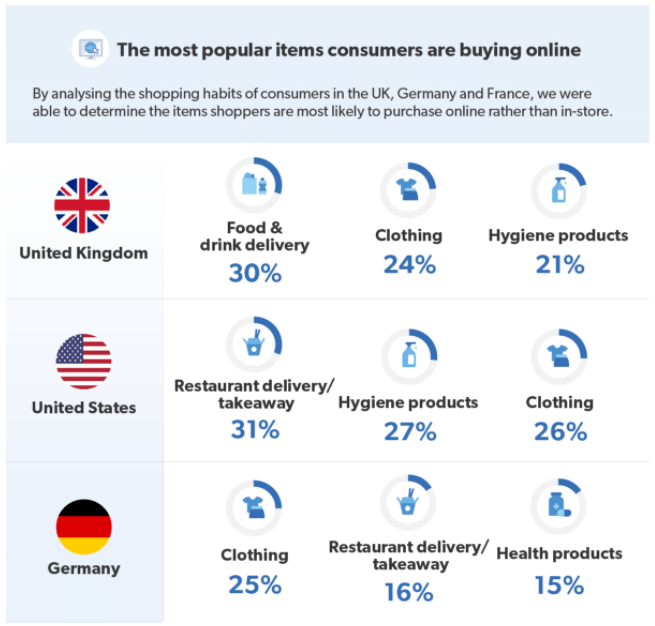
Although the majority would prefer to buy in person, food and drinks are one of the most popular items to buy online. 30% of UK residents favour buying supermarket goods over the internet, while 31% of Americans and 16% of Germans choose to purchase restaurant takeaway online.
Some consumers are also shifting towards buying clothes online. 26% of Americans, 25% of Germans and 24% of British people would deliberately order clothes over the internet rather than going into a store.
The world is spending more time shopping online
There is no doubt that there has been an increase in spending on e-commerce over the past year, despite high street shopping remaining the most favourable form of retail therapy. Although shoppers may have not made a complete shift from offline shopping to online, there has been an increase in the frequency of consumer spending in the e-commerce market.
Most notably are Vietnam shoppers. According to Statista, the South Asia country has seen a 57% increase in the amount spent shopping online. India and China have also seen major leaps in e-commerce spending (55% and 50% increase respectively).
With a rise of 16%, the UK has seen one of the smallest increases in the rate residents are spending online.
Take a look at the graphic below to see which other countries have seen a growth in the frequency of e-commerce spending.
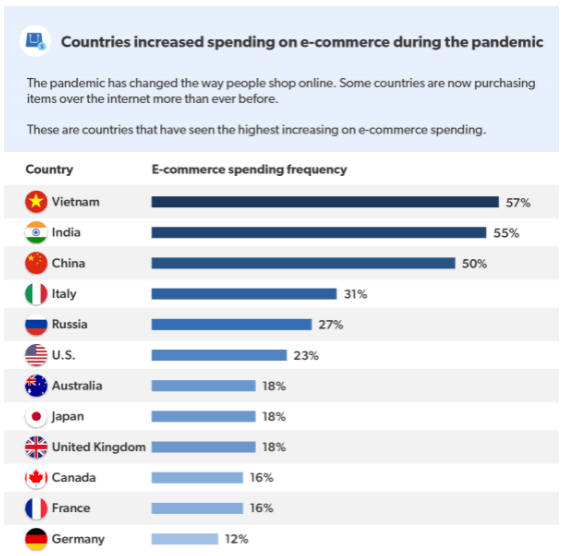
Ann, head of purpose at Spice Kitchen discussed with Savoo some of the shifts she noticed during the pandemic “We have noticed lots of interesting trends, the obvious one being the massive move toward online spending at the start of the pandemic. This allowed us to connect with our customers as they were looking for exciting meals to cook at home and our spices became very popular.
Also, there was a big shift towards wanting to support local and small businesses.
We are still seeing much more online purchases than prior to lockdown and feel like the world has changed for good. But, there is this continued shift to support local and small businesses"
As more people move to shopping for items online, the amount spent on e-commerce globally increases year on year. In fact, in 2014 $1,336B was spent in the e-commerce sector — this figure grew by 7.4% to $1,548B in 2015.
By 2020, $4,280B was being spent in the e-commerce market worldwide. If global spending continues to grow, we can predict that by the year 2024 $6,388B will be spent shopping online — that’s a 22% increase from 2014.

Conclusion
The full impact of the pandemic on the retail industry is yet to be fully known, but it is clear to see that there has been a shift in the industry and things are unlikely to ever be the same.
As online shopping continues to be a popular method for both consumers and retailers, it should be noted that we are not yet at a point in time where shopping is exclusively online. Customers still like to experience visiting the high street and going to physical stores.
The high street will continue to change as retailers adapt to the technological advancements that appear in the industry - closing the gap between digital and physical transactions. No matter the change, it is important that customer experience is put at the forefront.
Ed Fleming, Managing Director at Savoo, comments “The high street will never be the same again since the outbreak of COVID-19 as it has accelerated the movement to online shopping that had already started making waves before 2019 and 2020. The future of retail doesn’t solely lie in the hands of consumers - retailers have a huge part to play too in shaping the future of the customer experience.
With online retailers offering next day or even same-day delivery without shoppers having to leave their house, now is the time for the high street to adapt to consumer needs and tap into the key reasons consumers are still going into physical stores.
The pandemic has led to a change in shopping, which is here to stay. Consumers are now looking to support local businesses rather than chain stores and looking to make fewer trips to the high street.
In order for the high street to survive and stay as a staple in British culture, the shopping experience should remain at the forefront for retailers. Stores should be offering an experience that people can’t get online or on their phones if they want to keep attracting customers.
Although some consumers are reverting to the high street, retailers need to consider that there are factors at play now. As more competitors continue to pop up in online spaces, it should be noted that shoppers value that in-person experience that only the high street can offer."
Image by Tim Douglas, Pexels
Get discounts at these popular retailers with our voucher codes and promo codes
- Pets at Home
- MuscleFood
- early learning centre
- MyHeritage
- Roman Originals
- QVC
- Disney Store
- AliExpress
- Virgin Experience Days
- Jacamo
- G Adventures
- iHerb
- iScooter
- P&O Ferries
- Argos
- John Lewis
- Debenhams
- TUI
- Marks & Spencer
- SHEIN
- Very
- Buyagift
- Zavvi
- First Choice
- Dorothy Perkins
- New Look
- Karen Millen
- Footasylum
- Clarks
- H Samuel
- Ernest Jones
- Tesco
- Sainsbury's
- Interflora
- Hotel Chocolat
- Boots
- Holland and Barrett
- LOOKFANTASTIC
- The Body Shop
- B&Q
- Wickes
- Dunelm
- ao.com
- Currys
- Nike.com
- SPORTS DIRECT
- Halfords
- Myprotein
- Domino's
- boohoo
- Missguided
- HP
- Sky
- BT Broadband
- Travelodge
- lastminute
- Bulk
- Samsung
- Booking.com
- Boomf
- In The Style
- Pizza Hut
- Ted Baker
- Hive Home
- Omio
- Mindful Chef
- Amazon
- Amazon Prime Free Trial
- VonHaus
- Gtech
- BAM
- Home Essentials
- Alienware
- Gousto
- Moonpig
- Pandora
- Papa John's
- Toolstation
- eBay
- NordicTrack
- Bloom and Wild
- Quiz
- Asos
- Superdrug
- JD Sports
- Temu